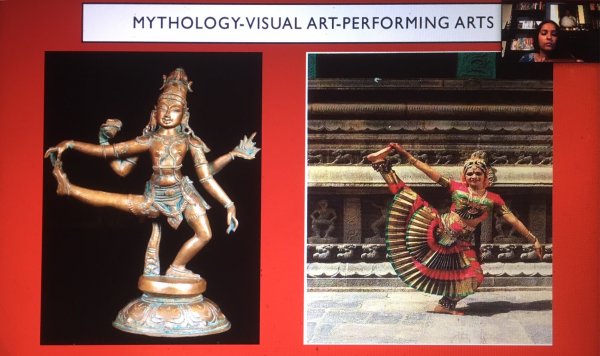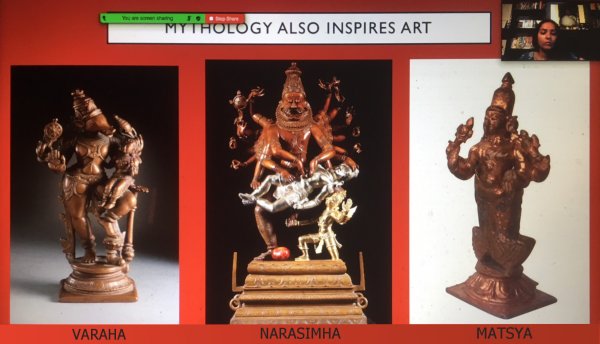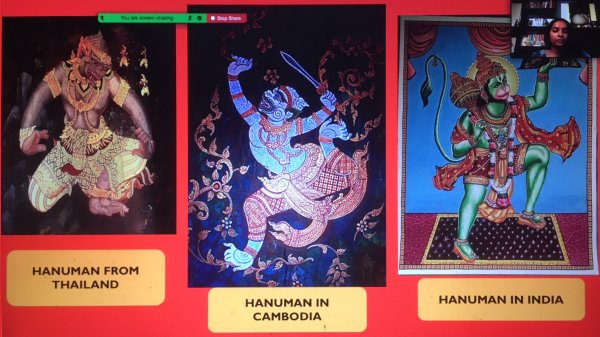
|
 |

|
 |
All roads lead to dance - Samyukta Ninan e-mail: Samyukta.Ninan@bluebellsinternational.com May 10, 2021 "Many people have said many things. I can only say I did not consciously go after dance. It found me." - Rukmini Devi Arundale There are not many moments in life when opportunities knock at your door. This I have discovered. But when they do, I should say embrace them and not let them go. About three years back, as an educator teaching history for nearly 11 years in a private school in Delhi, I believed that my relationship with my students was merely based on content transaction. Today I have completely changed this view, and that happened when dance found me. Being a student of history, I attach a huge importance to the origin of everything. The past appeals to me much more than the present. And this has helped me immensely in understanding dance. If one had to look simply at the 9,000 year old paintings found in the rock shelters of Bhimbetka, there are evidence of dancing figures drawn all over the cave walls. Is it possible that dance came even before the written language? Many historians claim that it did, as stories were orally performed using dance as a medium and passed down many generations. This makes it so much easier to understand why we respond to dance and music. It has been a very powerful medium of expression for centuries and continues to be so. We as educators at times tend to focus at learning based on all the possible data that we use for testing our students. Then again how much can we learn about an individual through a data driven test? Somewhere we as educators have forgotten that humans are the most beautiful species and there are layers and layers that never reach the surface, because we choose to see what we want to see. I began to think differently though, and for that I feel going back to learning dance helped me understand that learning cannot always be data driven.  Mythology - Visual art - Performing arts I am learning Bharatanatyam under my guru Geeta Chandran and a lot of her own interaction with us, her students, made me reflect a lot on my practices as an educator. This was definitely an important moment whereupon, while learning dance, I began to question my own methods of teaching. I reflected on what my actual role was as an educator. Was I to be merely seen as someone who transacts knowledge without a sense of purpose? Should I not go beyond the textbook? Can I empower my students to develop a love for Arts and Aesthetics as an extension to my history classes? Could I as an educator help them develop a strong sense of belonging with India? Armed with these questions in my mind, I began to re-look at my role as an educator. One of the first experiments with my students in class, was beginning with a Mira Bhajan, "Hari main toh", sung by the grand dame of Carnatic music M. S Subbulakshmi. I distinctly remember while dancing to this Bhajan in my dance class, I had felt a heightened sense of emotion, something that I had never experienced. This piqued my interest, could one feel so moved while listening to a song, and can that affect the way we perform? In my classroom I shared the same music with my students; the first five minutes went by. I could notice many of them shifting around, and I did feel that perhaps I was too hasty with my experiment. However a silence engulfed my class, they were lost in the song. It had taken them by surprise, my otherwise restless class seemed more focused and relaxed. That was the moment for me, where I believed that bringing in a new element to my class helped me give them an experience that they had never felt before. Throwing them off balance with music or even a dance piece, made them sit up and watch a performance carefully. Stories of all kinds enthrall me, and teaching students through storytelling is even more engaging. A lot of educators stick to the usual method of textbook teaching; I never use the textbook. In fact, the world outside the textbooks excites me. Children of all age groups have a vivid imagination, and it is an equally imaginative teacher who brings the world into her classroom. While my own engagement in dance has a huge role to play, I feel what fascinates me about dance is its own rich story telling tradition. For me dance is all about the story that it conveys using the dancer and the art in itself as its medium. When Bharata Muni composed the Natyasastra in the 2nd C BC, India had its first manual on classical dance. Even more fascinating is a story attached with it.The first dancers were the Apsaras (celestial dancers) who performed the first dance drama for a celestial audience. After the performance, Natyasastra narrates that Shiva suggested that dance and dance movements had to be part of every performance henceforth. The wise Sage Tandu after whom the dance Tandava was named, was requested to compose and curate dance performances. He was to teach dance movements to the celestial dancers. It is said that Bharata Muni then takes the help of the Apsaras to train actors and dancers to perform in another dance drama. Thus the idea of classical dance begins to take shape in these stories, and these stories find a way into my classrooms.  Mythology inspires art Classical dances are huge champions of Indian mythology; a large part of India's story telling traditions resides within the classical dances. My own understanding of mythology has increased mainly because of dance. I am not just a student learning the technicalities of Bharatanatyam, but I am delving into a holistic ocean that empowers the learner to go beyond what they see. In turn as an educator, I share my learnings and get my students to look deeply into the tangible and intangible diversity within India. While listening to the poetry of Andal, a female saint, in a webinar with dancer Anita Ratnam, I was able to share the same with my students. Our history classes went beyond textbooks, they talked about love, longing and devotion, yet they spoke about the power of the Bhakti movement. My students deeply looked at Indian myths as an extension of human creativity and imagination. The stories came alive and so did the performance, as many students began to seek events where stories were conveyed through classical dances. Travelling through India, again deeply inspired by what I was reading up on dance, has helped me immensely. While exploring the temples at Khajuraho built by the Chandelas, I realized how learning dance also heightened my sensitivity to Art and architecture. One is absolutely mesmerized by the sculptures and the massive grandeur that these temples come to represent. While exploring the temple complexes one comes across myriad symbolic icons that are an integral part of Indian aesthetics. One such sculptural image was that of the 'Dancing Ganesha.' The sculptural image of Ganesha is an outstanding work of craftsmanship; a huge favorite in the Hindu pantheon of gods, the craftsman has poetically in stone highlighted the joy with which Ganesha dances. One can see how the craftsman has brought in movement into the sculpture, and it's as if Ganesha is in a trance, oblivious to things around him. It is this trance that dance has the ability to bring out in everyone, and even gods share with us this feeling of absolute giddiness and abandonment to reason. The temples of Khajuraho were a visual treat to my eyes, the stories I had read and had seen been performed on stage were all culminating in front of me. I carried these impressions back to my class, where each class was about helping students look at Indian art as an extension of poetry, storytelling, visual art, performing arts and an Indian way of life. The fact that dance has opened so many avenues for me as an educator, has helped me build a strong bond with my students. Educational institutions have a huge responsibility in being a bridge between our kids and the Art and aesthetics of India. If that is the core of an institution, the strong sense of Indianness that we seem to be struggling to build in our schools will not be a problem at all. It's the visual and the performing arts that have the capacity of building global citizens of the world, where empathy and compassion are an integral part of school curriculums and creativity and innovation are not a distant dream. Schools must also use the performing arts to empower educators- as it is an educator who can bring all of this within her classrooms.  Ramayana in SE Asia  Iconography of Hanuman in SE Asia Delving into research is something again dance encouraged me to do. It began within my own dance classes, where we would research on the Ramayana, and study the original text. My Guru's experiment with us helped me further expand it in my own classes. I started a small project called 'Studying sacred texts', whereby I encouraged my students to pick sacred texts like the Bhagavad Gita, the Quran, the Bible and the Guru Granth Sahib and study them in detail. This was partly to get my students to explore texts and to help them understand the philosophy and ideas behind some of our ancient texts. I have to say, my students worked on it for 6 months, and surprised me. There were some hiccups initially, but I was able to create some enthusiasm for the research they were doing. I hope to carry forward this research with my students, that excitement gives me joy. For me as an educator, my interaction with dance has begun a journey that has excited me beyond anything. If anything, dance found me at my most vulnerable time, and provided the much needed therapy I needed to reinvent myself as an educator. With more and more platforms becoming online due to the current pandemic crisis, dance too has adapted to this. I have had the privilege to attend so many online performances in the past year, and a big salute to all the performers, these online events kept the morale of many people high. And not just performances, but dialogues and discussions on dance kept many of us engaged and pushed us to read more on classical arts. Indeed the performing arts has arrived and has thrived throughout the pandemic, and what an inspiration for us it is. For educators like me, dance has changed my entire purpose in life. I happened to glance through a blog on classical dance a while back and my eye chanced upon a quote written by an anonymous person, but I felt it conveyed what I have been feeling all along. Sometimes all you need is dance A therapy that brings you back to the person you are The best get away to the world of dance The cure of everything is to dance your heart out To find the creative side of life. Samyukta Ninan, disciple of Geeta Chandran, is an educator at Bluebells School International, New Delhi. Comments * It is an excellent and enriching piece. I truly believe that dance is for everybody. A noted American choreographer and dancer said, "To dance is to be out of yourself, larger, more beautiful, more powerful.... it is glory on earth and it is yours for the taking." I am glad to find the hidden language of dance in your writing. - Madhumanti Sengupta (May 21, 2021) * Dance is a universal form of expression and connection. It's been around for centuries and has evolved into an art form that people can see in every corner of the world. I also like to continue my passion with Geethalayam Bharatanatyam. - Sakthi (May 21, 2021) * Very well explained that dance can also be a part of social science class. Visual and performing arts are really very important in a classroom. We need to focus on it. - Bharati Thakur (May 19, 2021) * This is very informative. It is true that the past appeals more than present. And I think every human should know about this. Very well written. (May 17, 2021) * Informative and innovative article. (May 17, 2021) * A very well written and an inspiring article. Loved the human connection that this article appeals for. (May 11, 2021) Post your comments Pl provide your name and email id along with your comment. All appropriate comments posted with name & email id in the blog will also be featured in the site. |